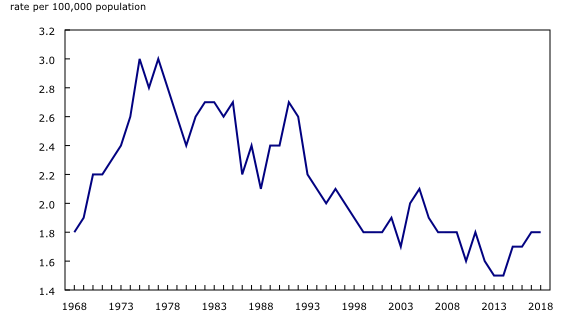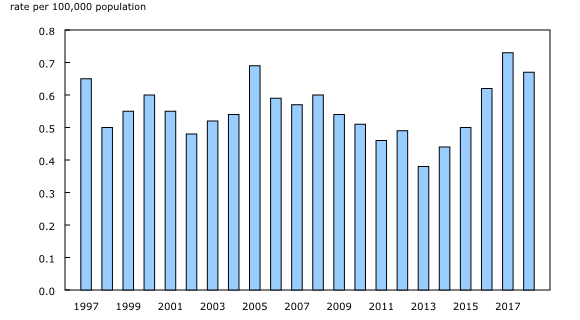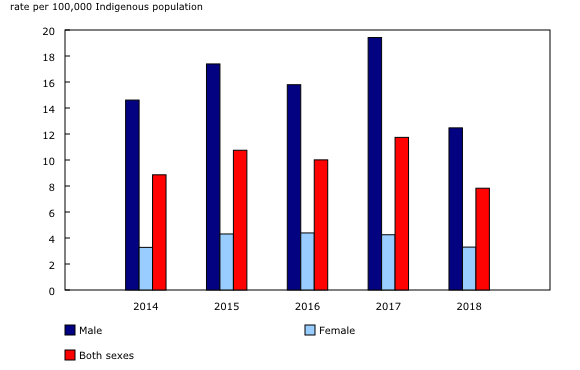Homicide in Canada, 2018
Archived Content
Information identified as archived is provided for reference, research or recordkeeping purposes. It is not subject to the Government of Canada Web Standards and has not been altered or updated since it was archived. Please "contact us" to request a format other than those available.
Released: 2019-11-27
Nationally, police reported 651 homicides in 2018, 15 fewer victims than the previous year. Although the homicide rate fell 4% in 2018 to 1.76 per 100,000 population, it remains higher than the national average for the previous decade.
While homicide continues to be a relatively rare occurrence, representing less than 0.2% of all violent crimes in Canada in 2018, homicide rates are considered benchmarks for levels of violent activity both in Canada and internationally.
Record high number of homicides in Ontario, while most other provinces report declines
At the provincial level, there were notably fewer homicides in Alberta (-38 homicides), British Columbia (-30), Quebec (-10) and Nova Scotia (-10) in 2018 than in 2017. In contrast, Ontario, with 69 more victims than in 2017, reported the largest year-over-year increase and the highest number of homicides since data collection began in 1961.This resulted in the highest homicide rate in Ontario since 1991 (1.86 per 100,000 population).
The record number for Ontario was mostly the result of the increase of 49 homicides that occurred in the census metropolitan area (CMA) of Toronto.
Detailed information on homicide in Canada is provided in the accompanying Juristat article released today, "Homicide in Canada, 2018" and in the "Infographic: Homicide in Canada, 2018."
Homicides decrease in Edmonton, Calgary and Vancouver but increase in Toronto and Windsor
In addition to Toronto, homicides increased in 13 other CMAs and decreased in 17. The largest declines were in Edmonton, Calgary and Vancouver, while the greatest increases were in Toronto and Windsor. Five CMAs reported no changes from the previous year.
Toronto has the highest number of homicides on record for a census metropolitan area
With 142 victims, Toronto, Canada's most populous CMA, had the most homicides among the CMAs in 2018 as well as the most homicides ever reported in any CMA since collection of homicide data by CMA began in 1981. This was a 53% increase in the number of victims and a 50% increase in the homicide rate from 2017 (from 1.51 victims per 100,000 population in 2017 to 2.26 victims per 100,000 population in 2018). The CMA of Toronto's high numbers in 2018 are partly explained by three notable incidents involving multiple victims that year: the discovery of eight victims of serial homicide committed during a seven-year period from 2010 to 2017; an attack in the North York City Centre business district of Toronto, where pedestrians were deliberately struck by a van; and a shooting on Danforth Avenue in Toronto's Greektown.
Firearm-related homicides down for the first time in five years
The national rate of firearm-related homicides declined 8% in 2018. This marks the first decrease of homicides committed with a firearm since 2013.
There were fewer firearm-related homicides in Alberta (-20), British Columbia (-18), Manitoba (-7), Quebec (-5), Nova Scotia (-4), Yukon (-2) and Nunavut (-1) compared with 2017. Overall, the decline in the number of firearm-related homicides was attributable to fewer firearm-related homicides in areas outside of CMAs (-20).
In contrast, Ontario reported 36 more firearm-related homicides, the majority occurring in CMAs. Toronto accounted for 14 of the additional 36 firearm-related homicides in the province, while the other CMAs accounted for 9. Of the increase in Toronto, 13 of the firearm-related homicides were not gang-related.
Prince Edward Island, Yukon, the Northwest Territories and Nunavut reported no firearm-related homicides in 2018.
Gang-related homicides down for the first time in four years
In 2018, gang-related homicides decreased (-5%) for the first time since 2014. However, the rate of gang-related homicides in 2018 was the second highest rate of gang-related homicides in Canada since comparable data were first collected in 2005.
The largest decreases in gang-related homicide were in British Columbia (-12 homicides) and Alberta (-9). In British Columbia, some of the decrease was attributable to fewer gang-related homicides in Kelowna and Abbotsford–Mission. The decline in Alberta was predominantly in Calgary (-8).
Although the number of gang-related homicides was down at the national level, the number of gang-related homicides more than doubled in the province of Quebec—from 15 victims in 2017 to 32 in 2018. The increase in Quebec was driven by an additional 9 homicides in Montréal and 4 in rural areas and small towns.
Approximately 8 out of every 10 gang-related homicides in Canada were committed with a firearm and, of these, 85% were committed with a handgun.
Rate of Indigenous homicide victims remains approximately five times higher than rate of non-Indigenous victims
There were 140 Indigenous victims of homicide in 2018, representing 22% of all homicide victims throughout Canada. The number of male Indigenous victims decreased for the first time since 2014 when data on Indigenous identity first became available, and was down 23 from 2017. There were six more Indigenous female victims of homicide in 2018 than in 2017, marking a second consecutive annual increase. Comparable to past years, the rate of homicide in 2018 for Indigenous people was approximately five times higher than the rate for non-Indigenous people (7.31 per 100,000 population for Indigenous people, compared with 1.44 for non-Indigenous people).
Rate of persons accused of homicide still approximately eight times higher for Indigenous accused than for non-Indigenous accused
Almost one-third (30%) of persons accused of homicide in 2018 were reported by police as Indigenous. This was down from the previous year (37%) and comparable with the 2014 level (31%), following three years of increases. Nevertheless, the rate of Indigenous persons accused of homicide in 2018 remains approximately eight times higher compared with non-Indigenous accused persons, a difference that has been similar in previous years.
Most victims know their killer
In terms of relationship, spousal homicide was the lone type of homicide to increase in 2018 (+9 victims). In contrast, there were 31 fewer homicides committed by someone with whom the victim had a criminal relationship (for example, drug dealers and their clients). Although much of the focus is often on homicides with a link to criminal activity, the majority of homicides in Canada are committed by an acquaintance (34%), a family member (33%), a stranger (19%), or someone with whom the victim had a current or former intimate relationship – non-spousal (6%). In 2018, 8% of victims were killed by someone with whom they had a criminal relationship.
Note to readers
The data presented in this article are drawn from the 2018 Homicide Survey, which collects police-reported information on the characteristics of all homicide incidents, victims and accused persons in Canada. The Homicide Survey began collecting information on all murders in 1961 and was expanded in 1974 to include all incidents of manslaughter and infanticide. Although details on these incidents are not available prior to 1974, counts are available from the Uniform Crime Reporting (UCR) Survey and have been included in the historical aggregate totals.
The term "homicide" is used to refer to each single victim of homicide. For instance, a single incident can have more than one victim and for the purpose of this article, each victim would be counted as a homicide.
The long-term homicide trend excludes the 329 victims killed in the Air India incident that occurred in 1985.
There are cases where homicides become known to police months or years after they occurred. These incidents are counted in the year in which they become known to police. New information pertaining to the detailed information on homicides that have already been reported to Statistics Canada is updated annually as is information on accused persons.
Due to revisions to the Homicide Survey database, annual data reported by the Homicide Survey prior to 2016 may not match the annual homicide counts reported by the UCR survey. Data from the Homicide Survey is appended to the UCR database each year for the reporting of annual police reported crime statistics.
Information on persons accused of homicide are only available for solved incidents (that is, where at least one accused has been identified). For incidents involving more than one accused, only the relationship between the victim and the closest accused is recorded.
Urban areas include police services in census metropolitan areas (CMAs) and census agglomerations (CAs). Rural refers to all areas outside of CMAs and CAs and includes rural areas and small towns.
For the purposes of the Homicide Survey, Indigenous identity includes those identified as First Nations persons (either status or non-status), Métis, Inuit or an Indigenous identity where the Indigenous group is not known to police. Non-Indigenous identity refers to instances where the police have confirmed that a victim or accused person is not identified as an Indigenous person.
Products
The Juristat article "Homicide in Canada, 2018" (85-002-X) is now available. The "Infographic: Homicide in Canada, 2018" (11-627-M) is also released today.
Additional data are available upon request.
Contact information
For more information, or to enquire about the concepts, methods or data quality of this release, contact us (toll-free 1-800-263-1136; 514-283-8300; STATCAN.infostats-infostats.STATCAN@canada.ca) or Media Relations (613-951-4636; STATCAN.mediahotline-ligneinfomedias.STATCAN@canada.ca).
- Date modified:









